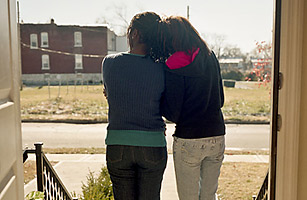
In many ways, Claire was a typical 14-year-old. Her favorite store was Forever 21, her favorite food was macaroni and cheese, and her favorite TV show was Bad Girls Club. As a ninth-grader living in St. Louis, she was a member of her school dance team, and she was on Facebook. A pretty and stylish girl, Claire was a strong student whose long-term goal was to become a lawyer. In other ways, however, Claire’s life was decidedly not typical, and the odds were seriously stacked against her. At age 6, she entered foster care after evidence of abuse and neglect surfaced in her home. She then lived in six different settings, including foster homes and group residences; her current home was a facility. Although she navigated those challenges with remarkable grace, her prospects were, statistically speaking, bleak. She would “age out” of the foster-care system when she turned 18, at which point she would have to fight to keep her head above water. There are nearly half a million American children in foster care; one 2007 survey found that of the young adults who age out, about half don’t complete high school, about a third are arrested, and almost as many struggle with homelessness. Only 38% of those working at age 18 are employed a year after leaving foster care, and among the women, roughly half are pregnant within 12 to 18 months. But in November 2009, Claire got a lucky break: her case was randomly selected to be part of an innovative program known as Extreme Recruitment. Pioneered by a 23-person St. Louis — based agency called the Foster & Adoptive Care Coalition, Extreme Recruitment seeks out the foster children who are the hardest to find homes for — kids older than 10, kids with special needs, sibling groups and African Americans — and not only matches them with permanent adoptive families but also does so in a fraction of the time such matches usually take. Success depends on close coordination of a professional team — one that includes detectives who track down enough potential adoptive relatives to fill a small dance hall. Although half of all foster kids wait in custody for one to five years, Extreme Recruitment aims for a match in 12 to 20 weeks; instead of finding “forever families” for 40% of the children they work with, as the agency did before 2008, Extreme Recruitment finds families for 70%. “We think it’s the best thing since sliced bread,” the coalition’s executive director, Melanie Scheetz, says of Extreme Recruitment. “But until we can prove it as an evidence-based practice, it’s just that nice little program that people are doing out in St. Louis.” In 2008 the coalition partnered with the state of Missouri on a five-year federal grant to compare Extreme Recruitment’s family-matching methods with foster-care business as usual — an evaluation Scheetz welcomes. As interest in the program rises and the coalition hosts visitors from around the country eager to observe and replicate its methods, Extreme Recruitment might remain just a nice little program out in St. Louis, or it might pave the way to revolutionize the foster-care system in America. The Need for Speed Extreme recruitment came about while its creator was waiting for Desperate Housewives to come on TV. That is the “very embarrassing but very true” story, as Scheetz describes it, of how she decided to dramatically shift the way her agency approached finding homes for children. She was sitting in front of the television in her family’s living room on a Sunday night in March 2008, impatiently watching the last few minutes of Extreme Makeover: Home Edition. “How can they build a house that fast?” she remembers wondering. “If they can do that — and they do it not because they use any new technologies or processes; they just coordinate their massive team of professionals and volunteers in a highly effective way — the question is why can’t we do that too in finding homes for kids?” Of the 424,000 American children currently in foster care, according to the Department of Health and Human Services’ Administration for Children and Families, close to a quarter will remain in care for more than three years. At the coalition prior to Extreme Recruitment, a social worker typically checked in with a child’s caseworker once a month, and the various other players — the educational advocate, the therapist, the court-appointed special advocate — were rarely in the same room.See a brief history of the American family.